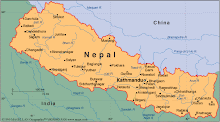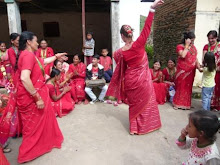




A couple of weeks ago I traveled 12 hours by bus to one of our offices in Western Nepal. The bus ride there was pretty difficult. The seat in front of me hit my knees, one food break, and temperatures around 105 degrees. At least the bus was vibrant, however, with its Bollywood music, ornate ceiling work, brilliant colors and carousel-style poles that reminded me of the circus, beautiful tin handiwork around the edges of the inside and an altar on the dashboard with bright, flashing lights and burning incense.
Our office in Dang district is run by folks from the Tharu community - the indigenous group from the area. The Tharu have lived in the jungles of southern Nepal for thousands of years. In fact, they have lived in the jungles so long that their DNA developed a resistance to malaria.
When the West came in and sprayed DDT everywhere (to get rid of the Malaria mosquitoes), however, the land then was taken away from the Tharu by people who would have before never been safe entering. For a long time the Tharu were forced to work as indentured servants for the upper castes, but recently have been freed by the government.
My colleagues invited me to stay in the village with them, as the volunteers and board members of the organization they are starting up could then easily come over for meetings over tea or meals.
I stayed with Lissim(above, to the right of me) and two other women in one of the most beautiful houses I've seen in Nepal. It was simple: bricks and mud, two stories, rounded edges, small and large alcoves, wood fire kitchen, store rooms for beans, vegetables and rice, and a well out back for water. The structure of the house keeps it cool in the summer and warm in the winter.
Lissim told me she doesn't like her house, however, and wouldn't believe me when I told her that people back home only dream about houses as artistically and beautifully crafted as this.
I visited 5 women's groups in villages around the area and - along with our staff - and talked with them about their needs. In all 5 communities their answers were the same: first and most important need: access to water. Second: a community space for women to meet. Third, some way to generate income. I would guess that these women have to find a way to live off of much less than a dollar a day.
I will go back to Dang in September and will, along with our staff at the district level, co-create and co-facilitate leadership and advocacy trainings that we will provide in the villages. The hope is that we can create something that - after I leave- the staff can facilitate on their own. I will also be looking for funding for programs that might benefit these communities.
While I am not looking forward to the bus ride back to Dang in September, it seems a small price to pay for the opportunity to visit my new friends there - Salikram ji and Lissim ji and the rest of their organization. I can't wait to return.



2 comments:
What wonderful descriptions! I wish you could have shown some pictures of the dwelling you describe. But that would be an invasion of privacy, wouldn't it?
This is really powerful, Tiff. I know the challenges of being there can be so big. But it really is true, though, huh, that in the end it's worth it?
I just got back to Portland last night. Rain, temps in the upper 50s. I'm saying hello to your city for you...
Post a Comment